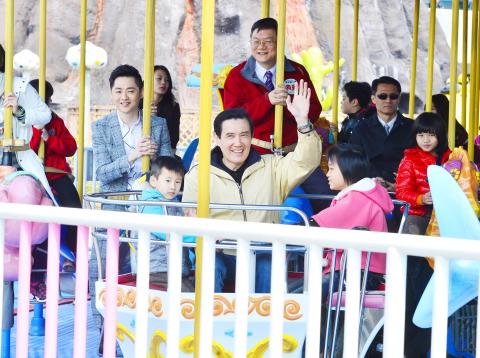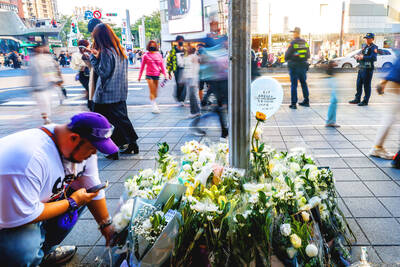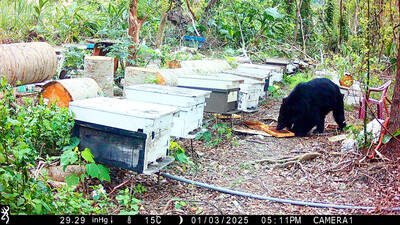President Ma Ying-jeou (馬英九) said in an interview released yesterday that both he and Chinese President Xi Jinping (習近平) are well aware that the conditions for the unification of the two sides of the Taiwan Strait are lacking at present.
In an interview with CNN reporter Christiane Amanpour, Ma said that China certainly desires unification and has never given up on the idea, according to a Chinese-language transcript released by the Presidential Office.
However, China is willing to develop relations with Taiwan peacefully on the basis of the so-called “1992 consensus” of “one China, different interpretations” because it knows that pushing for immediate unification would not achieve good results and would even have serious consequences, Ma said.

Photo: Wang Yi-sung, Taipei Times
Former Mainland Affairs Council chairman Su Chi (蘇起) admitted making up the term “1992 consensus” in 2000.
During his meeting with Xi in Singapore in November last year, he told Xi that the “one China, different interpretations” model adhered to by the Republic of China (ROC) will not be interpreted as “two Chinas,” “one China, one Taiwan,” or “Taiwanese independence,” Ma said.
“Our interpretation is of course based on our Constitution, which can only be ‘the Republic of China,’” he said, adding that the model has provided an appropriate and mutually acceptable basis for cross-strait relations over the past eight years.
When asked to reflect on why the Chinese Nationalist Party (KMT) lost the Jan. 16 elections and whether he read the election results as a backlash against his China policy and cross-strait trade pacts, Ma said that while there are people in Taiwan opposed to his China policy, they only account for a small proportion, not a majority.
“We all understand that over the past eight years of my presidency, we have created a status quo, and this status quo has won the support of the majority,” he said.
When asked how Xi interpreted the election results and how he views president-elect Tsai Ing-wen (蔡英文), who “potentially has a slightly different view when it comes to relations with China,” Ma said Xi over the past year stressed on several occasions that “the 1992 consensus is the key.”
“Of course we hope that my successor will think carefully about supporting the 1992 consensus, allowing cross-strait ties to move ahead smoothly, so when Taiwan tries to develop its international relations, we can face a more friendly environment,” Ma said.
“I believe that the people of Taiwan support a free and democratic political system, and hope that the ROC will continue to become more free and democratic,” Ma said when asked about the younger generation in Taiwan, who might feel more nationalistic, preferring a full-blown democracy.”
“However, when we develop relations with China, we have to establish a mutually accepted consensus so that this relationship will move ahead peacefully and smoothly,” Ma said.
When asked about Itu Aba Island (Taiping Island, 太平島), Ma said the ROC recovered the island in 1946 and at the time, Vietnam and the Philippines did not express any opinion.
In 1956, Taiwan began stationing troops there, and has done so till now, he said, adding: “We have been in control of Taiping Island for 60 years.”

SHIPS, TRAINS AND AUTOMOBILES: The ministry has announced changes to varied transportation industries taking effect soon, with a number of effects for passengers Beginning next month, the post office is canceling signature upon delivery and written inquiry services for international registered small packets in accordance with the new policy of the Universal Postal Union, the Ministry of Transportation and Communications said yesterday. The new policy does not apply to packets that are to be delivered to China, the ministry said. Senders of international registered small packets would receive a NT$10 rebate on postage if the packets are sent from Jan. 1 to March 31, it added. The ministry said that three other policies are also scheduled to take effect next month. International cruise ship operators

NUMBERS IMBALANCE: More than 4 million Taiwanese have visited China this year, while only about half a million Chinese have visited here Beijing has yet to respond to Taiwan’s requests for negotiation over matters related to the recovery of cross-strait tourism, the Tourism Administration said yesterday. Taiwan’s tourism authority issued the statement after Chinese-language daily the China Times reported yesterday that the government’s policy of banning group tours to China does not stop Taiwanese from visiting the country. As of October, more than 4.2 million had traveled to China this year, exceeding last year. Beijing estimated the number of Taiwanese tourists in China could reach 4.5 million this year. By contrast, only 500,000 Chinese tourists are expected in Taiwan, the report said. The report

HORROR STORIES: One victim recounted not realizing they had been stabbed and seeing people bleeding, while another recalled breaking down in tears after fleeing A man on Friday died after he tried to fight the knife-wielding suspect who went on a stabbing spree near two of Taipei’s busiest metro stations, Taipei Mayor Chiang Wan-an (蔣萬安) said. The 57-year-old man, identified by his family name, Yu (余), encountered the suspect at Exit M7 of Taipei Main Station and immediately tried to stop him, but was fatally wounded and later died, Chiang said, calling the incident “heartbreaking.” Yu’s family would receive at least NT$5 million (US$158,584) in compensation through the Taipei Rapid Transit Corp’s (TRTC) insurance coverage, he said after convening an emergency security response meeting yesterday morning. National

The Forestry and Nature Conservation Agency yesterday launched a gift box to market honey “certified by a Formosan black bear” in appreciation of a beekeeper’s amicable interaction with a honey-thieving bear. Beekeeper Chih Ming-chen (池明鎮) in January inspected his bee farm in Hualien County’s Jhuosi Township (卓溪) and found that more than 20 beehives had been destroyed and many hives were eaten, with bear droppings and paw prints near the destroyed hives, the agency said. Chih returned to the farm to move the remaining beehives away that evening when he encountered a Formosan black bear only 20m away, the agency said. The bear